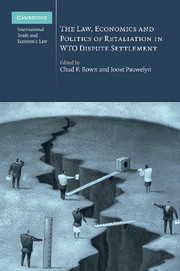Book contents
- Frontmatter
- Contents
- List of tables and figures
- Contributors
- Introduction: trade retaliation in WTO dispute settlement: a multi-disciplinary analysis
- PART I Background and goal(s) of WTO retaliation
- PART II A legal assessment after ten arbitration disputes
- 4 The law of permissible WTO retaliation
- 5 From Bananas to Byrd: damage calculation coming of age?
- PART III An economic assessment after ten arbitration disputes
- PART IV The domestic politics and procedures for implementing trade retaliation
- PART V Problems and options for reform
- PART VI New frontiers and lessons from other fields
- Index
4 - The law of permissible WTO retaliation
Published online by Cambridge University Press: 26 February 2010
- Frontmatter
- Contents
- List of tables and figures
- Contributors
- Introduction: trade retaliation in WTO dispute settlement: a multi-disciplinary analysis
- PART I Background and goal(s) of WTO retaliation
- PART II A legal assessment after ten arbitration disputes
- 4 The law of permissible WTO retaliation
- 5 From Bananas to Byrd: damage calculation coming of age?
- PART III An economic assessment after ten arbitration disputes
- PART IV The domestic politics and procedures for implementing trade retaliation
- PART V Problems and options for reform
- PART VI New frontiers and lessons from other fields
- Index
Summary
Introduction
This chapter seeks to provide an account of the manner in which Article 22.6 arbitrators have gone about their task of fitting ‘punishment’ (retaliation) to ‘crime’ (the continuing violation of WTO law). The treaty text provides only sparse instructions on how to carry out this task and, as a consequence, arbitrators and WTO members have been left to develop their own solutions in individual cases.
The task of this chapter is essentially descriptive. As a ‘state-of-play’ account it looks back at the arbitral awards issued to date and isolates the legal approaches used by arbitrators, examines the issues they have confronted, while applying those approaches in individual cases and discusses the justifications offered for particular approaches and choices. The chapter does touch (lightly) on the thorny matter of evaluation of arbitral awards and the related issue of what the proper ‘purpose’ or ‘objective’ of WTO remedies is or should be, but, on the whole, its task is to construct an accurate description. The task of providing prescriptions is left for other contributors to this volume.
It is structured as follows: section 1 provides an overview of the basic features of the WTO enforcement mechanism; section 2 describes the procedural aspects; sections 3–6 are the core of the chapter and describe how arbitral panels have controlled the form and magnitude of retaliation in the ten cases decided to date; and section 7 briefly discusses the question of how the arbitral panels have viewed the purpose of retaliation.
- Type
- Chapter
- Information
- Publisher: Cambridge University PressPrint publication year: 2010
- 1
- Cited by



